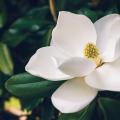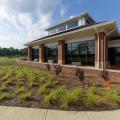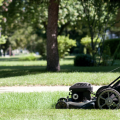Successful Shade Gardens
 Often viewed as a constraint for producing sun loving flower gardens, shade conditions in residential gardens offer many benefits as well.
Often viewed as a constraint for producing sun loving flower gardens, shade conditions in residential gardens offer many benefits as well.
In addition to providing much needed relief from the summer sun in outdoor areas, shade trees reduce summer cooling needs on homes when properly sited in southern or western locations. Deciduous shade trees also allow the winter sun through the open canopy to provide extra heat for residences in the cool season. Shade trees offer valuable food, nesting habitat, and shelter for a wide variety of birds and mammals.
Unfortunately, shade areas are unsuitable for growing sun loving turfgrasses that are common to our region. St. Augustine grass is the most shade-tolerant lawngrass, but still requires at least a half day of sun to perform well. Trees may be thinned of branches to allow extra sunlight into the yard yet must be pruned on a regular basis. A more successful approach to working with shady areas is to incorporate plants that are adapted to low light conditions.
There are varying degrees of shade according to the density and types of trees that are present. Full or dense shade occurs when the trees are broad-leaved, including areas containing Southern magnolia, oaks, maples, and many other hardwood types. Light shade or filtered light occurs when the trees are high branched, have an open canopy, or have fine thin leaves. Pine trees are an example of providing light shade or filtered light. Half shade or part shade occurs when an area receives full sunlight for part of the day and is shaded during the remainder. Areas adjacent houses or other structures that cast shadows for part of the day, or woodland areas adjacent open lawn spaces are examples of partially shaded locations.
Selecting appropriate plants for shade areas depends upon the degree of light available. Dense shade areas require plants that are tolerant of continuous low light conditions. Light shade or half shade areas allow for a broader range of flowering plants. Even full sun loving plants can benefit from light afternoon shade, and as long as they receive six to eight hours of direct sunlight, will continue to bloom or fruit.
Few shade plants will provide a continuous bloom through the seasons as found with many sun loving plants. Impatiens and begonias are shade annuals that provide extended summer color, yet require frequent irrigation. Competition for moisture from the surrounding tree roots must be compensated for these moisture-requiring annuals. Drought tolerant shade annuals, perennials, and shrubs are more successful in low maintenance garden conditions.
Since there are few continuously blooming shade plants, using plants that exhibit other design elements such as texture, form, and foliage color can result in outstandingly beautiful shade gardens. By creating plant combinations that contrast or compliment each other in plant shape, leaf size, and leaf texture, flowers are often unnecessary for interest. Try using plants that exhibit bold leaf colors such as ajuga, variegated hydrangea, or caladiums. Dramatic leaf sizes and textures of plants, as found in mahonia, fatshedera, fatsia, oakleaf hydrangea, and dwarf palmetto, create strong visual interest. Also, ferns, vines, groundcovers, and perennials are effective for variety and seasonal contrast.
The following list contains plants that are well-suited to growing in shaded areas. Ask your local nurseryman about their adaptability and performance in your gardening area.
| TREES | ||||
| Common name | Botanical name | Shade level | Height | Characteristics |
| Japanese red maple | Acer palmatum | Part shade | 25' | Fall color |
| Red maple | Acer rubrum | Part shade | 60' | Fall color |
| Devil's walking stick | Aralia spinosa | Part shade | 30' | Textured leaf |
| Ironwood | Carpinus caroliniana | Part to full | 30' | Muscular trunk |
| Dogwood | Cornus florida | Part shade | 30' | White spring flower |
| American beech | Fagus grandifolia | Part to full | 80' | Tan winter leaves |
| Parasol tree | Firmiana simplex | Part shade | 40' | Green trunk |
| Silverbell | Halesia diptera | Part shade | 30' | White spring flowers |
| Southern magnolia | Magnolia grandiflora | Part to full | 80' | Summer flowers |
| Bigleaf magnolia | Magnolia macrophylla | Part to full | 70' | White spring blooms |
| Red oak | Quercus falcate | Part to full | 80' | Textured leaf |
| Live oak | Quercus virginiana | Part to full | 60' | Spreading limbs |
| SHRUBS | ||||
| Bear's Breech | Acanthus mollis | Part shade | 30" | Coarse texture leaf |
| Red buckeye | Aesculus pavia | Part to full | 20' | Spring blooms |
| Beautyberry | Callicarpa americana | Part to full | 8' | Purple fall fruit |
| Sweet shrub | Calycanthus floridus | Part to full | 10' | Maroon spring bloom |
| Camellia | Camellia japonica | Part shade | 20' | Winter flowers |
| Strawberry bush | Euonymus americana | Part shade | 6' | Red summer fruit |
| Fatsia | Fatsia japonica | Part to full | 6' | Tropical leaf |
| Witch hazel | Hamamelis virginiana | Part shade | 25' | Winter blooms |
| Mountain hydrangea | Hydrangea arborescen | Part to full | 5' | White summer bloom |
| Indigo | Indigofera kirilowii | Part shade | 2' | Pink spring blooms |
| Japanese pieris | Pieris japonica | Part shade | 8' | White spring flowers |
| Flame azalea | Rhododendron austr. | Part shade | 12' | Yellow spring blooms |
| Dwarf palmetto | Sabal minor | Part to full | 6' | Textured leaf |
| VINES | ||||
| Pepper vine | Ampelopsis arborea | Part shade | 15' | Black fruit |
| Rattan vine | Berchemia scandens | Part to full | 80' | Curling trunk |
| Climbing hydrangea | Decumaria barbara | Part to full | 30' | White spring flower |
| Fatshedera | Fatshedera lizei | Part to full | 15' | Tropical leaf |
| Creeping fig | Ficus pumila | Part shade | 40' | Fine texture leaf |
| Algerian ivy | Hedera canariensis | Part shade | 10" | Coarse texture leaf |
| Maypop | Passiflora incarnate | Part shade | 15' | Summer flowers |
| GROUNDCOVERS | ||||
| Bugle weed | Ajuga reptans | Part to full | 3" | Purple leaf |
| Wild ginger | Asarum canadense | Part to full | 1' | Heart shape leaf |
| Cardamon ginger | Amomum compactum | Part shade | 2' | Tropical leaf |
| Cast iron plant | Aspidistra elatior | Part to full | 3' | Tropical leaf |
| Holly fern | Cyrtomium falcatum | Part to full | 3' | Evergreen leaf |
| Liriope | Liriope muscari | Part to full | 1' | Grassy leaf |
| Royal fern | Osmunda regalis | Part to full | 3' | Bold leaf |
| Autumn fern | Dryopteris erythrosora | Part to full | 2' | Copper foliage |
| Partridgeberry | Mitchella repens | Part to full | 1' | Red summer fruit |
| Mondo grass | Ophiopogon japonicus | Part to full | 5" | Fine grassy leaf |
| White violet | Viola odorata | Part shade | 5" | White spring flower |
| PERENNIALS | ||||
| Elephant ear | Alocasia macrorrhiza | Part shade | 6' | Large tropical leaf |
| Christmas berry | Ardisia japonica | Part to full | 1' | Red winter fruit |
| Jack in the pulpit | Arisaema triphyllum | Part to full | 1' | Spring blooms |
| Umbrella plant | Cyperus alternifolius | Part shade | 4' | Umbrella leaf |
| Hosta | Hosta spp. | Part to full | 2' | Leaf color |
| Leopard plant | Ligularia tussilaginea | Part to full | 2' | Leaf texture |
| Mayapple | Podophyllum peltatum | Part to full | 2' | Leaf texture |
| Trillium | Trillium spp. | Part to full | 1' | Red spring flower |
These factsheets were written by Robert F. Brzuszek, Assistant Extension Professor, The Department of Landscape Architecture, Mississippi State University.
Publications
News
Landscape design and natural landscape enthusiasts will gather at Mississippi State University to perfect their craft and learn from other experts, an annual event happening this year on Oct. 18. The 68th Edward C. Martin Landscape Symposium will be held from 8:30 a.m. to noon at the Bost Auditorium at MSU.
May is here and you know what that means, it’s go time!




